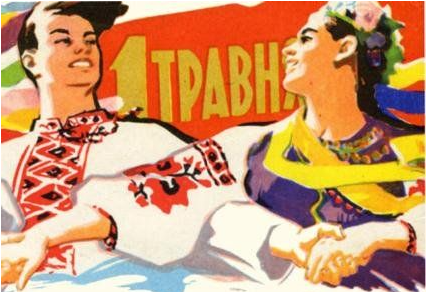
Photo: t1
[For urgent updates please follow Ukrainian Freedom News on Telegram]
The heroic war against the Russian invaders has been going on in Ukraine for more than two months, and in its context, many movements of decommunization and de-Russification intensified. One of the issues actively discussed on social networks is whether to celebrate May 1 – the Labour Day, which was celebrated yeaterdays in various forms and different states, although in Ukraine, it’s often considered in relation to the country’s socialist past.
Lviv Now asked Serhii Humennyi, Doctor of Philosophy in History, Research Fellow at the Faculty of History of Kyiv National University, whether it is worth celebrating May Day, renaming streets devoted to Russian cultural and scientific figures, and whether it is possible to completely abandon the Soviet heritage.
Should the May Day celebration be canceled? In Ukraine, it carries with it a purely Soviet narrative. Is this day celebrated in Europe?
We associate this holiday with the Soviet Union. But it is celebrated not only in the former Soviet Union. In fact, the holiday itself was a tribute to the protests in the United States in the late 19th century, when workers demanded an eight-hour working day. In the days of «wild capitalism,» which began in the mid-nineteenth century, workers in the United States and other industrialized countries were heavily exploited. The working day lasted 12 hours or more, and both women and children worked. Therefore, workers constantly demanded a reduction in the working day and, at least, minimal civil rights.
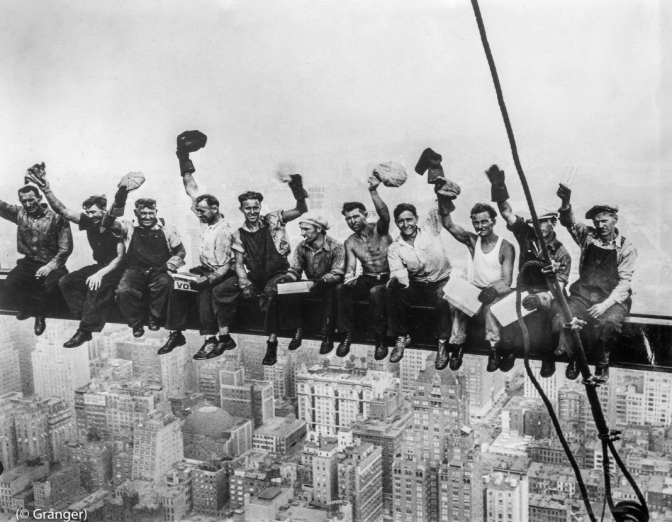
Workers sit on a beam during construction in New York. Photograph of 1932 (© Granger)
Therefore, abroad, this International Labor Day is more associated with American workers’ protests. Of course, communist ideology has always speculated on the labor movement, so it introduced this holiday as one of the measures of its ideological leadership over the labor movement.
If I am not mistaken, the Congress of the Second International [International Union of Socialist Workers’ Parties, founded in 1889 – Ed.] decided on the international celebration of this holiday. But it was at the end of the XIX century, when there was no Soviet Union.
In Lviv, Labor Day (which was often called earlier as «Lvivska Maivka») was celebrated in 1890, during the Austro-Hungarian Empire, 20 years before the First World War. Galicia was a center of oil production at that time, and workers were severely exploited, so they supported this progressive holiday. Ivan Franko and Mykhailo Pavlyk were present at the Lviv demonstration that day. They took an active part in the creation of the first Ukrainian political party – the Rus’-Ukrainian Radical Party (RURP). Therefore, as we see, the elements of the Labor Day celebration were present before the Soviet Union but had a different understanding. In Soviet times, however, the party strongly «clung» to this popular holiday among workers and actively used it.
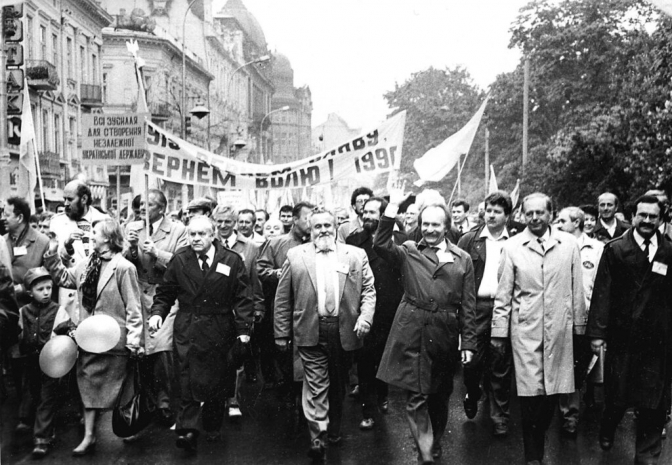
«Lvivska Maivka», 1990
Should we pursue a strong state policy of commemoration in order to rethink this date, postpone this holiday to another day, or simply cancel it?
In 2017, certain steps have already been taken in Ukraine. Verkhovna Rada made amendments and rename the Day of International Workers’ Solidarity to Labor Day. In principle, it is better to actualize it to the events of the Lviv Maivka in 1890. You can rely on them.
The holiday itself should simply be stripped of May Day Soviet myths. I do not see a Soviet connotation in it because we had precedents for celebrating it before the USSR. They are worth paying attention to. There are other holidays that have a specific Soviet connotation, and it’s worth paying attention to them during decommunization. For example, the May 9, which some still celebrate. At the same time, the holidays before the Soviet period should be correlated with the holidays in our history or, some other ways out should be found. This, in fact, began with the renaming of the holiday by parliament in 2017, when it began to be linked to the events in Galicia.
What do you think about the policy of radical de-Russification that is being implemented now, the separation from everything Russian: names, place names, literature, etc.?
We are in wartime now. Although it has been going on since 2014, its active phase has come this time. And at that time, everything is radicalized. Therefore, such actions are justified.
We have common historical events, not only with Russia. We have them with both Poland and Lithuania (during the time of the Grand Duchy of Lithuania). But our common historical events and cultural figures are not much commemorated in our public space.
After all, all these names are «markers» that are not only in the topography, but also in the standard perception of the environment in which we live. For example, if we have a lot of Russian literature at school, a lot of titles related to Russia, then over time, we perceive it as the norm.
Read also: It’s harder than decommunization. What do we have to do with the Russian culture
If we are looking for a basis to show our difference, we should probably, where possible, pay attention to some resources of our own history and culture. In the context of studying literature or history, we can pay more attention to European models. We still have European integration, and for a long time, the territory of Ukraine has been an integral part of Europe. We were part of the state union, which is now called the distant prototype of the European Union, the Polish–Lithuanian Commonwealth.
And most of our toponyms on the map of Kyiv belong to the XIX – XX centuries. This is clearly seen in the example of metro stations. The last renaming was the station «Petrivka» to «Pochayna». Pochayna is an ancient river in Kyiv, but for a long time, the station was named «Petrivka» in honor of a Soviet party figure. Was he connected to that area? No. He had a certain relation to Kyiv. Abroad, metro stations, such as Prague or Warsaw, are named after the area. This experience is successfully implemented in our country as well. I hope that the future renaming of Kyiv metro stations will also focus on the historical toponyms of the capital, or be dedicated to the figures not connected to the Russian world.
The second example: there have been problems with the Pushkin monument in Ternopil for a long time. In fact, according to some sources, Pushkin visited Ternopil, but most sources indicate that he did not. Because in the 1820s, when he was supposed to be in Ternopil, Pushkin was in Bessarabia under the supervision of the governor. Therefore, the need for a monument to Pushkin in Ternopil was neither aesthetic nor commemorative. It was simply a «marker» of the arrival of Soviet power there and its establishment.
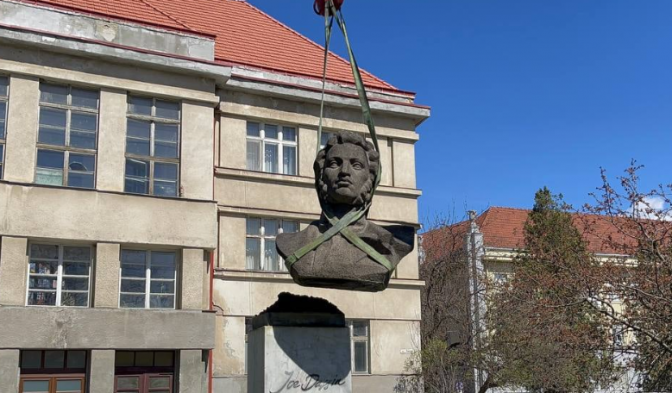
In the photo: dismantling of Pushkin's bust in Uzhgorod
Similarly, the Soviet government created a monument to the so-called reunification of eastern and western Ukraine on the basis of Ternopil National Medical University. In fact, it was a monument to the occupation of Galicia by Soviet troops. This bas-relief was dismantled a long time ago, and Pushkin has not yet been touched, because it is an element of Russian culture that ran parallel and did not seem to intersect with Russian politics.
I believe that the policy of total de-Russification is justified because wartime requires it. Just as the air defense system needs a distinction between «Own/stranger», so we need this in the field of national memory too.
Especially since the society in Ukraine is post-genocidal. We survived the Holodomor, all the events of the early and mid-20th century, and now, we are actually experiencing a second genocide.
When Russia occupies new territories, it places those «markers» of public memory. It occupied the south of Ukraine, and is restoring monuments to Lenin. Why? Are all Russians communists? No, it’s just that they and local collaborators are trying to label the area as post-Soviet or future Soviet, or as they see it, depending on the camp to which they belong. Because there are imperialists and communists in Russia.
Read also: Getting rid of the remnants of communism symbols. Photoset from the Hill of Glory in Lviv
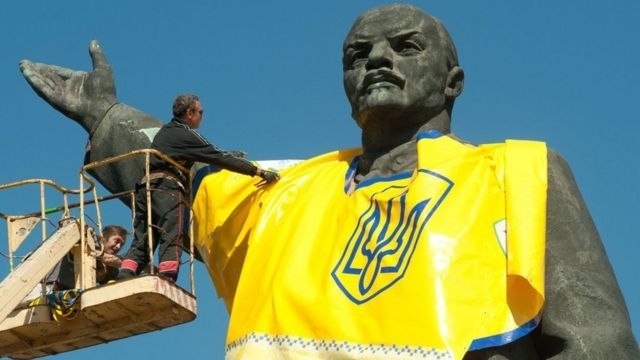
Photo: Lenin in Zaporizhzhia, UNIAN. The monument was first disguised and then demolished
Therefore, all sides during the hot phase of the war carry out this «marking» of territories and «marking» of consciousness. This is how human memory works. This could have happened gradually and in more balanced forms, but since it has existed in our history for a long time, de-Russification is now taking place radically.
Should we reject absolutely all Soviet heritage?
I believe that we should not reject everything. For example, we must not abandon the achievements of the period of Ukrainization [policy of the Russian Communist Party (bolsheviks) – All-Union Communist Party (bolsheviks) in 1920 – 1930 to neutralize the national liberation aspirations of the Ukrainian people and strengthen Bolshevik power in the Ukrainian USSR – ed.].
We do not like the monuments to Lenin, and we do not need them. But I think that there may be evidence that the policy of Ukrainization was pursued, and there must be some memory of those people. Yes, they were communists, but at least they were for Ukrainian culture, and some, such as Oleksandr Shumskyi [1890 – 1946, Ukrainian Soviet statesman and politician, one of the leaders of the national communist movement. People’s Commissar for Internal Affairs and Education – ed.], believed that Ukraine should be socialist, but exist separately from Russia.
It will still not be possible to completely abandon the Soviet heritage, as many urban objects, such as the constructivism of the 1920s, are already a heritage of Ukrainian culture. We can’t give up Dniproges [Dnipro hybroelectric power station], we can’t give up the central architectural ensemble of Kharkiv. This is already a certain element of our culture, which is not lent to us by the Soviet Union, but is an adaptation of our local environment.
For example, the school of Boychukists [a constellation of monumental painters, students, and followers of Mikhail Boychuk, representatives of «red art» and «red culture» 1920-1950s. Their work influenced the minds of artists up to the 1990s, ed.].
Therefore, it cannot be said that everything in the Soviet Union was black and white. At least in the 1920s, there was something that Ukrainian cultural and national thought could keep.
By Roman Tyshchenko-Lamansky, translated by Kateryna Bortniak
Follow us on Facebook and Instagram. Lviv Now is an English-language website for Lviv, Ukraine’s «tech-friendly cultural hub.» It is produced by Tvoe Misto («Your City») media-hub, which also hosts regular problem-solving public forums to benefit the city and its people.












